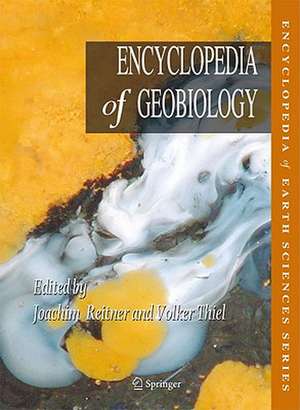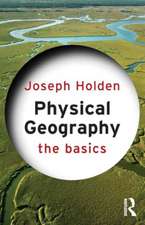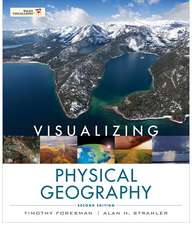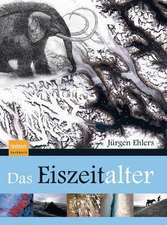Encyclopedia of Geobiology: Encyclopedia of Earth Sciences Series
H.W. Fritz Editat de Joachim Reitner Andreas Kappler Editat de Volker Thiel Kurt Konhauser, Pamela Reid, Xingliang Zhangen Limba Engleză Hardback – feb 2011
Din seria Encyclopedia of Earth Sciences Series
- 18%
 Preț: 3655.93 lei
Preț: 3655.93 lei - 18%
 Preț: 3123.97 lei
Preț: 3123.97 lei - 18%
 Preț: 2565.22 lei
Preț: 2565.22 lei - 18%
 Preț: 2828.03 lei
Preț: 2828.03 lei - 18%
 Preț: 3984.35 lei
Preț: 3984.35 lei - 18%
 Preț: 3380.49 lei
Preț: 3380.49 lei - 18%
 Preț: 3917.94 lei
Preț: 3917.94 lei - 18%
 Preț: 3354.74 lei
Preț: 3354.74 lei - 18%
 Preț: 3664.42 lei
Preț: 3664.42 lei - 18%
 Preț: 1901.16 lei
Preț: 1901.16 lei - 18%
 Preț: 3381.42 lei
Preț: 3381.42 lei - 18%
 Preț: 3041.93 lei
Preț: 3041.93 lei - 18%
 Preț: 3055.49 lei
Preț: 3055.49 lei - 24%
 Preț: 2488.11 lei
Preț: 2488.11 lei - 24%
 Preț: 2672.36 lei
Preț: 2672.36 lei - 18%
 Preț: 1849.26 lei
Preț: 1849.26 lei - 24%
 Preț: 3581.28 lei
Preț: 3581.28 lei - 18%
 Preț: 2802.01 lei
Preț: 2802.01 lei - 24%
 Preț: 1685.69 lei
Preț: 1685.69 lei - 18%
 Preț: 3335.19 lei
Preț: 3335.19 lei - 24%
 Preț: 2953.23 lei
Preț: 2953.23 lei - 24%
 Preț: 1685.16 lei
Preț: 1685.16 lei - 14%
 Preț: 2198.30 lei
Preț: 2198.30 lei - 9%
 Preț: 1677.87 lei
Preț: 1677.87 lei - 14%
 Preț: 1632.61 lei
Preț: 1632.61 lei - 14%
 Preț: 1849.25 lei
Preț: 1849.25 lei - 14%
 Preț: 2571.45 lei
Preț: 2571.45 lei - 14%
 Preț: 1945.55 lei
Preț: 1945.55 lei - 14%
 Preț: 1945.55 lei
Preț: 1945.55 lei - 14%
 Preț: 1945.55 lei
Preț: 1945.55 lei - 14%
 Preț: 1945.55 lei
Preț: 1945.55 lei - 9%
 Preț: 2703.17 lei
Preț: 2703.17 lei - 14%
 Preț: 1945.55 lei
Preț: 1945.55 lei - 14%
 Preț: 1945.55 lei
Preț: 1945.55 lei - 14%
 Preț: 2130.90 lei
Preț: 2130.90 lei
Preț: 1689.69 lei
Preț vechi: 2223.28 lei
-24% Nou
Puncte Express: 2535
Preț estimativ în valută:
323.37€ • 336.35$ • 266.95£
323.37€ • 336.35$ • 266.95£
Carte tipărită la comandă
Livrare economică 10-16 aprilie
Preluare comenzi: 021 569.72.76
Specificații
ISBN-13: 9781402092114
ISBN-10: 1402092113
Pagini: 956
Ilustrații: XXVIII, 927 p. 482 illus., 32 illus. in color.
Dimensiuni: 210 x 279 x 56 mm
Greutate: 2.95 kg
Ediția:2011
Editura: SPRINGER NETHERLANDS
Colecția Springer
Seria Encyclopedia of Earth Sciences Series
Locul publicării:Dordrecht, Netherlands
ISBN-10: 1402092113
Pagini: 956
Ilustrații: XXVIII, 927 p. 482 illus., 32 illus. in color.
Dimensiuni: 210 x 279 x 56 mm
Greutate: 2.95 kg
Ediția:2011
Editura: SPRINGER NETHERLANDS
Colecția Springer
Seria Encyclopedia of Earth Sciences Series
Locul publicării:Dordrecht, Netherlands
Public țintă
ResearchCuprins
Acetogens.-Acid Rock Drainage.-Acidophiles.-Aerobic Metabolism.-Algae (Eukaryotic) .-Alkalinity.-Amber.-Anaerobic Oxidation of Methane with Sulfate.-Anaerobic Transformation Processes, Microbiology.-Anammox.-Animal Biocalcification, Evolution.-Animal Skeletons, Advent.-Archaea.-Arsenic.-Asteroid and Comet Impacts.-Astrobiology.-Bacteria.-Bacterioplankton.-Banded Iron Formations.-Basalt (Glass, Endoliths) .-Beggiatoa.-Biodeterioration (of Stone).-Bioerosion.-Biofilms.-Biofilms and Fossilization.-Biogeochemical Cycless.-Biological Control on Diagenesis: Influence of Bacteria and Relevance to Ocean Acidification.-Biological Volcanic Rock Weathering.-Biomarkers (Molecular Fossils) .-Biomarkers (Organic, Compound-Specific Isotopes) .-Biomining (Mineral Bioleaching, Mineral Biooxidation) .-Bioprotection.-Biosignatures in Rocks.-Biosilicification.-Black Shales.-Breakup of Rodinia.-Calcareous Algae.-Calcification.-Calcified Cyanobacteria.-Calcite Precipitation, Microbially Induced.-Calcium Biogeochemistry.-Cap Carbonates.-Carbon (Organic, Cycling) .-Carbon (Organic, Degradation) .-Carbon Cycle.-Carbon Isotopes.-Carbonate Environments.-Carbonates.-Cathodoluminescence Microscopy.-Chemolithotrophy.-Cherts.-Chondrites.-Chroococcidiopsis.-Clay Authigenesis, Bacterial.-Coccolithophores.-Cold Seeps.-Comets.-Commensalism.-Community.-Copper.-Cosmic Molecular Clouds.-Critical Intervals in Earth History.-Cryobiosphere.-Cyanobacteria.-Deep Biosphere of Salt Deposits.-Deep Biosphere of Sediments.-Deep Biosphere of the Oceanic Deep Sea.-Deep Fluids.-Degradation (of Organic Matter) .-Denitrification.-Desert Varnish.-Detachment.-Diatoms.-Dinoflagellates.-Divalent Earth Alkaline Cations in Seawater.-Diversity.-Dolomite, Microbial.-Early Earth.-Early Precambrian Eukaryotes.-Ecological Niche<.-Ediacaran Biota.-Endoliths.-Endosymbiosis.-Evaporites.-Exoenzymes.-Extracellular Polymeric Substances (EPS) .-Extreme Environments.-Fe(II)-Oxidizing Prokaryotes.-Fe(III)-Reducing Prokaryotes.-Fermentation.-Fluorescence In Situ Hybridization (FISH) .-Foraminifera.-Frutexites.-Fungi and Lichens.-Gallionella.-Geobacter.-Geochronology.-Geomycology.-Geyserite.-Glass.-Glaucophytes.-Gold.-Gondwanaland, Formation.-Great Oxygenation Event (GOE) .-Green Algae.-Guild.-Habitat.-Halobacteria – Halophiles.-Haptophytes.-Heavy Metals.-Histology.-Hot Springs and Geysers.-Hydrogen.-Hydrothermal Environments, Fossil.-Hydrothermal Environments, Marine.-Hydrothermal Environments, Terrestrial.-Hypersaline Environments.-Ichnology.-Immunolocalization.-Iron Isotopes.-Iron Sulfide Formation.-Isotope Fractionation (Metal) .-Isotopes (Methods) .-Isotopes and Geobiology.-Isotopes, Radiogenic.-Karst Ecosystems.-Lateral Gene Transfer.-Leptothrix.-Magnetotactic Bacteria.-Manganese (Sedimentary Carbonates and Sulfides) .-Mass Extinctions, Phanerozoic.-Mat-Related Sedimentary Structures.-Metagenomics.-Metalloenzymes.-Metallogenium.-Metals, Acquisition by Marine Bacteria.-Meteoritics.-Methane Oxidation (Aerobic) .-Methane, Origin.-Methanogens.-Microbial Biomineralization.-Microbial Communities, Structure, and Function.-Microbial Degradation.-Microbial Ecology of Submarine Caves.-Microbial Mats.-Microbial Silicification – Bacteria (or Passive) .-Microbial Surface Reactivity.-Microbialites, Modern.-Microbialites, Stromatolites, and Thrombolites.-Microbial-Metal Binding.-Microbiocorrosion.-Microsensors for Sediments, Microbial Mats, and Biofilms.-Molar-tooth Structure.-Moonmilk.-Mud Mounds.-Mutualism.-Mycorrhizae.-Nan(n)obacteria.-Nanocrystals, Microbially Induced.-Nickel, Biology.-Nitrification.-Nitrogen.-Nitrogen Fixation.-Ores, Microbial Precipitation and Oxidation.-Organic Carbon.-Organomineralization.-Origin of Life.-Origins of the Metazoa.-Parasitism.-Pedogenic Carbonates.-Permafrost Microbiology.-Phosphorus, Phosphorites.-Photosynthesis.-Piezophilic Bacteria.-Pore Waters.-Protozoa (Heterotroph, Eukaryotic) .-Pyrite Oxidation.-Radioactivity (Natural) .-Radiolaria.-Raman Microscopy (Confocal) .-Reduction Spheroids.-Reefs.-Remineralization (of Organic Matter) .-Rhodophyta.-RNA-World.-Saline Lakes.-Salinity History of the Earth’s Ocean.-ScanningProbe Microscopy (Includes Atomic Force Microscopy) .-Sediment Diagenesis – Biologically Controlled.-Selenium.-Shales.-Shewanella.-Siderite.-Siderophores.-Silica Biomineralization, Sponges.-Silicoflagellates.-Sinter.-Skeleton.-Small Shelly Fossils.-Snowball Earth.-Soda Lakes.-Soda Ocean Hypothesis.-Soils.-Species (Microbial) .-Speleothems.-Sponges (Porifera) and Sponge Microbes.-Stromatactis.-Stromatolites.-Subsurface Filamentous Fabrics.-Sulfate-Reducing Bacteria.-Sulfide Mineral Oxidation.-Sulfur Cycle.-Sulfur Isotopes.-Symbiosis.-Syntrophy.-Terrestrial Deep Biosphere.-Thioester World.-Thiomargarita.-Thiotrophic Bacteria.-Thrombolites.-Tidal Flats.-TOF-SIMS.-Trace Fossils: Neoproterozoic.-Tufa, Freshwater.-Waulsortian Mud Mounds.-Whale and Wood Falls.-Zinc.
Recenzii
From the reviews:
“This new encyclopedia features 228 articles written by 165 experts worldwide. … deal with a wide range of topics, including micro- and macro- organisms, the relationship between life-forms and geologic environments, features and deposits, and biogeochemical processes. … The Encyclopedia of Geobiology is the only comprehensive volume on the topic presently available. … some would be understandable to undergraduates, but most would be more useful to graduate students and professionals. Summing Up: Recommended. Research collections serving graduate students through professionals in the earth sciences.” (L. R. Zellmer, Choice, Vol. 49 (1), September, 2011)
“There are about 200 full entries … in this encyclopaedia. … The book is well laid out. There are a reasonable number of diagrams and maps and many pictures. … I enjoyed rummaging through this book and learned a lot. Any one involved in geobiology (or either component partner) will get good value from this volume.” (John Goodier, Reference Reviews, Vol. 26 (1), 2012)
“This new encyclopedia features 228 articles written by 165 experts worldwide. … deal with a wide range of topics, including micro- and macro- organisms, the relationship between life-forms and geologic environments, features and deposits, and biogeochemical processes. … The Encyclopedia of Geobiology is the only comprehensive volume on the topic presently available. … some would be understandable to undergraduates, but most would be more useful to graduate students and professionals. Summing Up: Recommended. Research collections serving graduate students through professionals in the earth sciences.” (L. R. Zellmer, Choice, Vol. 49 (1), September, 2011)
“There are about 200 full entries … in this encyclopaedia. … The book is well laid out. There are a reasonable number of diagrams and maps and many pictures. … I enjoyed rummaging through this book and learned a lot. Any one involved in geobiology (or either component partner) will get good value from this volume.” (John Goodier, Reference Reviews, Vol. 26 (1), 2012)
Notă biografică
Dr. Joachim Reitner is Professor of Paleontology, Head of the Department of Geobiology, and Managing Director of the Museum, Collections and Geopark, at the University of Göttingen, Germany. He is also Editor-in-Chief of Lecture Notes in Earth Sciences (Springer), Co-Editor of Facies (Springer), and Associate Editor of the Geomicrobiology Journal (Taylor & Francis).
Dr. Reitner’s research focuses on the interplay between organisms and their metabolic processes with various abiotic parameters. Many geological processes can be understood as geo-physiological processes, allowing chemical reactions that would never run under standard thermodynamic conditions. Therefore, a major thrust of Dr. Reitner’s research activities is the investigation of the evolution of these processes, visible in biosignatures and biomineralization patterns and their interaction with biogeochemical cycles.
Among his many honors and accolades, Dr. Reitner is the recipient of the G. W. Leibniz Award from the Deutsche Forschungsgemeinschaft.
Dr. Volker Thiel is Professor of Organic Geochemistry in the Geoscience Center at the University of Göttingen, Germany. Dr. Thiel has been involved in geobiological research for some 15 years, with a focus on the use of organic molecules as chemical tracers (biomarkers) for biogeochemical pathways.
His research interests include lipid biomarkers as indicators for biogeochemical processes; molecular fossils, biological formation, and turnover of methane; and microbial control on mineral formation. The results of his studies have significantly contributed to identifying the microbial processes associated with methane turnover in modern and ancient environments. Much of Dr. Thiel’s current work is devoted to new approaches to enhance the spatial resolution of biomarker analysis in geobiological systems.
Dr. Reitner’s research focuses on the interplay between organisms and their metabolic processes with various abiotic parameters. Many geological processes can be understood as geo-physiological processes, allowing chemical reactions that would never run under standard thermodynamic conditions. Therefore, a major thrust of Dr. Reitner’s research activities is the investigation of the evolution of these processes, visible in biosignatures and biomineralization patterns and their interaction with biogeochemical cycles.
Among his many honors and accolades, Dr. Reitner is the recipient of the G. W. Leibniz Award from the Deutsche Forschungsgemeinschaft.
Dr. Volker Thiel is Professor of Organic Geochemistry in the Geoscience Center at the University of Göttingen, Germany. Dr. Thiel has been involved in geobiological research for some 15 years, with a focus on the use of organic molecules as chemical tracers (biomarkers) for biogeochemical pathways.
His research interests include lipid biomarkers as indicators for biogeochemical processes; molecular fossils, biological formation, and turnover of methane; and microbial control on mineral formation. The results of his studies have significantly contributed to identifying the microbial processes associated with methane turnover in modern and ancient environments. Much of Dr. Thiel’s current work is devoted to new approaches to enhance the spatial resolution of biomarker analysis in geobiological systems.
Textul de pe ultima copertă
The interplay between Geology and Biology has shaped the Earth from the early Precambrian, 4 billion years ago. Moving beyond the borders of the classical core disciplines, Geobiology strives to identify cause-and-effect chains and synergisms between the geo- and the biospheres that have been driving evolution of life in modern and ancient environments. Combining modern methods, geobiological information can be extracted not only from visible remains of organisms, but also from organic molecules, rock fabrics, minerals, isotopes and other tracers. Exploring these processes and their signatures also creates enormous applied potentials with respect to issues of environment protection, public health, energy and resource management. The Encyclopedia of Geobiology is designed as a key reference for students, researchers, teachers, and the informed public to provide basic, but comprehensible knowledge on this rapidly expanding discipline at the interface between modern geo- and biosciences.
Caracteristici
The only key resource in the rapidly expanding area of geobiology Cross disciplinary conception from the outset and execution Extensive and comprehensible compilation of modern geobiological methods Includes supplementary material: sn.pub/extras









